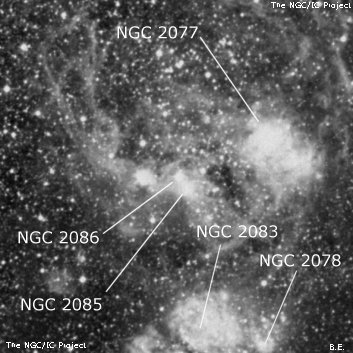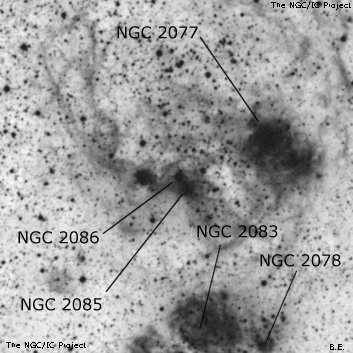NGC/IC Project Restoration Effort
(This is a very very beta version)
NGC2086


Basic Information
Location and Magnitude
Right Ascension: 5:40:13.0
Declination: -69:40:5
Constellation: DOR
Visual Magnitude:
Historic Information
Discoverer: Dunlop
Year of discovery: 1826
Discovery aperture: 9.0
Observational
Summary description: B, pS, R, lbM, * 10 p
Sub-type: EN
Corwin's Notes
=====
NGC 2086 = IC 2145. JH is very clear in his description of this object:
B, pS, R, lbM; follows a star 10m with other S sts about it. Not observed
in sweeping, but laid down in the drawing of Dec 4, 1837, whence its place
is derived, [Plate] III, [panel] 4.
His position is also quite good, but that was not enough to prevent both
Andris and me from taking JH's 10th magnitude star as NGC 2086 (the star is
actually closer to NGC 2085, so that is what I've called it in the position
table). The object is clearly shown in Herschel's sketch, directly east of
the star. (See NGC 2077 for a bit more about this sketch.)
Williamina Fleming rediscovered the object on an objective prism plate taken
late in the 19th century. She, too, did not give it its NGC number in her
paper in Harvard Circular No. 60, so it has also acquired an IC number.
Steve Gottlieb recovered the correct numbering during one of his Australian
trips in 2007 or 2008.
Steve's Notes
=====
NGC 2086
24" (4/9/08 - Magellan Observatory, Australia): this is the eastern component of a close pair of nebulous glows with NGC 2085 just 1.2' W. This pair is part of a fascinating group of numerous emission nebulae (LMC-N160 and LMC-N159) just 35' S of the Tarantula nebula. At 200x with a UHC filter, this knot appears very bright (slightly brighter than NGC 2085), fairly small, round, ~30" diameter. Without a filter, a faint star is near the center. Mag 10 supergiant HD 269953 (misidentified as NGC 2086 in the ESO catalogue), which is nearly attached to the NE side of NGC 2085, lies 1' W.



